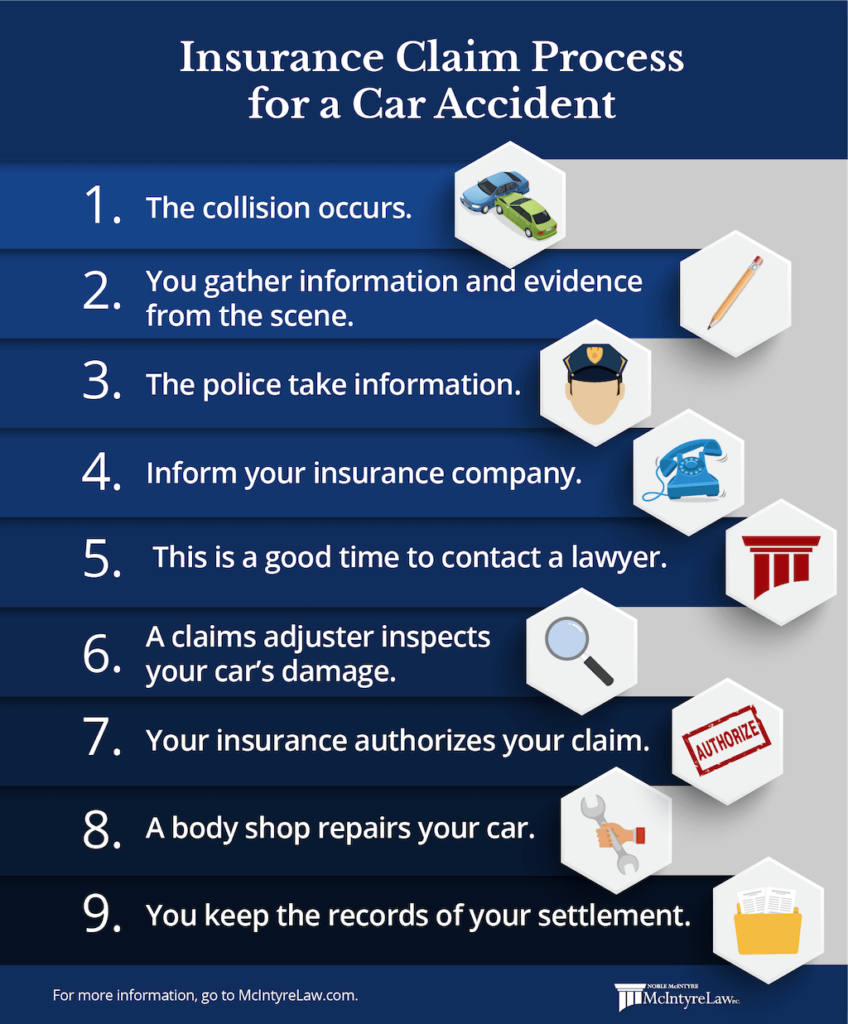Filing A Claim
If you’re involved in a car accident, it’s important to take steps to protect your rights and get the compensation you deserve. One of the most important steps is to file a car accident claim. This process can be complex and time-consuming, so it’s important to be prepared. Here’s a step-by-step guide to filing a car accident claim:
- Gather evidence. After an accident, it’s important to gather as much evidence as possible. This includes taking photos of the damage to your car, getting the names and contact information of any witnesses, and obtaining a copy of the police report.
- Report the accident to your insurance company. You should report the accident to your insurance company as soon as possible. They will be able to help you file a claim and get your car repaired or replaced.
- File a claim with the other driver’s insurance company. If the other driver was at fault for the accident, you will need to file a claim with their insurance company. You can do this by calling the company directly or by submitting a claim online.
- Negotiate a settlement. Once you have filed a claim, the insurance company will investigate the accident and determine how much you are entitled to. You may be able to negotiate a settlement with the insurance company without going to court.
What to Expect After Filing a Claim
Once you have filed a car accident claim, you can expect the insurance company to investigate the accident and determine how much you are entitled to. This process can take several weeks or even months. During this time, the insurance company may ask you to provide additional information or documentation. You should cooperate with the insurance company’s investigation so that they can make a fair settlement offer.
Getting Legal Help
If you are unable to reach a settlement with the insurance company, you may want to consider getting legal help. An attorney can help you negotiate a fair settlement or represent you in court. If you are seriously injured, it is important to get legal help as soon as possible so that you can protect your rights.
Conclusion
Car accident claims can be complex and stressful, but understanding the process can help you navigate it more effectively. By following these steps, you can increase your chances of getting a fair settlement for your injuries and damages.
Process of Car Accident Claim
Immediately after a car accident, report it to the police and exchange information with the other driver(s) involved. These are just a couple of steps to handle when filing a car accident claim. If you have been injured in a car accident, it is important to know what steps to take to file a claim. This article will provide you with a step-by-step guide on how to file a car accident claim.
1. Report the Accident
Immediately after a car accident, you should report it to the police. This is important for several reasons. First, it will create a record of the accident that can be used as evidence in your claim. Second, it will help the police to investigate the accident and determine who was at fault. Third, it will provide you with a police report that you can use to file your claim with your insurance company.
2. Gather Evidence
After you have reported the accident to the police, you should start gathering evidence to support your claim. This evidence can include:
- Photos of the accident scene
- Witness statements
- Medical records
- Property damage estimates
- Lost wage statements
To bolster your case even more, consider obtaining a copy of the police report as well. The more evidence you have, the stronger your claim will be.
3. File a Claim with Your Insurance Company
Once you have gathered all of the necessary evidence, you should file a claim with your insurance company. You can do this by calling your insurance company or by visiting their website. When you file a claim, you will need to provide the following information:
- Your name and contact information
- Your policy number
- The date and location of the accident
- The names and contact information of the other driver(s) involved
- The details of the accident
- The evidence that you have gathered
4. Negotiate with the Insurance Company
Once you have filed a claim, the insurance company will investigate the accident and determine how much they will pay on your claim. Depending on the company’s findings, you may need to negotiate with them to get a fair settlement. When negotiating with the insurance company, it is important to be prepared to provide evidence to support your claim. You should also be prepared to compromise. At the end of the day, you want to set yourself up for success to win the case.
Navigating the Process of a Car Accident Claim
When misfortune strikes in the form of a car accident, navigating the aftermath can be daunting. From ensuring your health and safety to seeking compensation, it’s crucial to understand the process and safeguard your rights. Here’s a comprehensive guide to help you navigate the intricacies of filing a car accident claim:
2. Seek Medical Attention
Even if you don’t feel injured immediately, it’s essential to get a medical evaluation. Some injuries, such as whiplash, may not manifest until hours or days later. A thorough checkup can identify any hidden damage and ensure prompt treatment.
3. Gather Evidence and Document the Incident
Thoroughly document the accident for your claim. This includes:
- Exchanging Information: Collect insurance details, driver’s licenses, and contact information from all parties involved.
- Taking Photos and Videos: Capture images of the vehicles, any injuries, and the accident scene.
- Obtaining Witness Statements: If there were any witnesses, request their contact information and statements.
- Creating a Written Report: Jot down the details of the accident, including the time, date, and description of what happened.
4. File a Claim with Your Insurance Company
Report the accident to your insurance provider promptly and provide them with the evidence you’ve gathered. They will investigate the claim and determine the next steps.
5. Negotiate with the Other Driver’s Insurance Company
If the other driver is at fault, their insurance company will be responsible for your damages. Be prepared to negotiate a fair settlement that covers medical expenses, property damage, and other losses.
6. Consider Legal Representation
If the insurance companies can’t agree on a settlement or if you’ve suffered severe injuries, consider seeking legal representation. An attorney can advocate for your rights and maximize your compensation.
Remember, the process of filing a car accident claim can be complex, but by following these steps and seeking professional guidance when necessary, you can protect your health, safety, and financial well-being.
Process of Car Accident Claim
Getting into a car accident is a stressful and overwhelming experience. Knowing what to do following an accident can support and help you protect your rights and ensure a smooth claims process. Here are the essential steps involved in filing a car accident claim.
1. Ensure Your Safety
First and foremost, ensure your safety and the safety of others involved in the accident. Move your vehicle to a safe location if possible. Check for injuries and call 911 immediately if anyone requires medical attention.
2. Exchange Information
Once you’re safe, exchange information with the other driver(s) involved. This includes your name, address, phone number, insurance company, and policy number. Take pictures of the damage to both vehicles and the accident scene.
3. Contact Your Insurance Company
Report the accident to your insurance company as soon as possible. Provide them with all the details of the accident, including the other driver’s information, the time and location of the accident, and any witnesses. They will assign you a claims adjuster who will guide you through the process.
4. Gather Evidence
To support your claim, gather as much evidence as possible. Take pictures of the damage to your vehicle, the other vehicle(s) involved, and the accident scene. Obtain a copy of the police report, if there was one. Collect witness statements from anyone who saw the accident. Keep all medical bills, repair estimates, and other documentation related to the accident.
5. File a Claim
Once you have gathered all the necessary information, file a claim with your insurance company. They will review your claim and determine liability. You may need to provide additional documentation or attend an examination under oath. The insurance company will then make a settlement offer, which you can accept or negotiate.
6. Negotiate a Settlement
If you’re not satisfied with the insurance company’s initial settlement offer, you can negotiate for a higher amount. Provide documentation to support your claim, such as medical bills, lost wages, and pain and suffering. You may also consider getting an attorney to represent you in the negotiation process.
7. Accept or Reject the Settlement
Once you have negotiated a settlement, you will need to decide whether to accept or reject it. If you accept, you will sign a release form and receive payment from the insurance company. If you reject the settlement, you can file a lawsuit against the other driver or their insurance company.
The Process of a Car Accident Claim: A Comprehensive Guide for Victims
Unfortunately, being involved in a car accident can be a stressful and traumatic experience. It is of paramount importance to remain calm, focus on safety, and prioritize your well-being. Once you have ensured everyone’s safety, filing an insurance claim is the next step to getting back on your feet. Here’s a detailed six-step guide to help you navigate the process of making a car accident claim:
Step 1: Seek Medical Attention
Your well-being should always take precedence. Seek immediate medical attention even if you don’t feel any discomfort. Injuries can manifest themselves later on, and seeking prompt medical care will create a record of your condition, which will be essential for your insurance claim.
Step 2: File a Police Report
Documenting the accident with an official police report is crucial. It provides an impartial account of the events and can strengthen your claim. Make sure to obtain a copy of the report for your records and insurance company.
Step 3: Notify Your Insurance Company
Time is of the essence when it comes to insurance claims. Promptly notify your insurance company about the accident. They will assign an adjuster to your case and guide you through the claims process. The sooner you report the incident, the sooner your claim can be processed.
Step 4: Gather Evidence
Collating evidence is vital to support your claim. Take photos of the accident scene, including damage to vehicles and any visible injuries. If possible, obtain statements from witnesses who can corroborate your account of events. Additionally, secure a copy of the police report and any medical records pertaining to your injuries.
Step 5: File Your Claim
The crux of your claim lies in providing a thorough account of the accident to your insurance adjuster. This includes detailing the events leading up to the collision, describing the property damage, and outlining your injuries and their impact on your life. Be as accurate and detailed as possible, as this information will form the basis of your claim’s evaluation.
When describing the accident, don’t be shy about using vivid language and evocative words. It’s not just about recounting the facts; it’s about painting a picture that helps the adjuster understand your experience. Describe the screech of brakes, the sickening thud of impact, and the chaos that ensued. Use metaphors and similes to convey the intensity of the moment. For instance, you could say that the impact felt like being “thrown into a washing machine” or that the car was “mangled like a tin can.”
Don’t hold back when it comes to describing your injuries. Use concrete examples to illustrate the pain, discomfort, and limitations you’re facing. Explain how the accident has affected your daily life – from simple tasks like getting dressed or cooking to more significant challenges like attending work or pursuing hobbies. By using personal pronouns and conversational language, you can connect with the adjuster on a human level and make your claim more compelling.
Remember, your insurance adjuster is not an adversary but rather a partner in the claims process. By providing a clear and detailed account of your experience, you’re not only advocating for your financial recovery but also giving the adjuster a fuller picture of the impact the accident has had on your life.
Step 6: Follow Up Regularly
Once you’ve filed your claim, don’t assume it will be processed and paid out automatically. Follow up with your insurance adjuster regularly to check on the status of your claim and provide them with any additional information or documentation they need. The more proactive you are, the faster your claim will be resolved.
Navigating the Process of Car Accident Claims: A Comprehensive Guide
If you’ve been involved in a car accident, navigating the claims process can feel like a daunting maze. Don’t worry, we’re here to unravel the complexities and guide you through each step, providing a detailed roadmap to help you get the compensation you deserve.
1. Safety First: Take Immediate Action
The aftermath of a car accident is often chaotic. But amidst the confusion, it’s crucial to prioritize safety. First, ensure you and any passengers are out of harm’s way. Call 911 to report the accident and seek medical attention if necessary.
2. Document the Scene: Gather Evidence
Next, it’s time to gather as much evidence as possible. Take photos of the accident site, including the vehicles involved, property damage, and any visible injuries. Exchange contact and insurance information with the other drivers and obtain police reports if available.
3. Notify Your Insurance Provider
Inform your insurance company about the accident promptly. They will guide you through the claim process and assign an adjuster to handle your case. Be prepared to provide a detailed account of the incident and submit any evidence you’ve gathered.
4. Seek Medical Attention: Protect Your Health
Even if you don’t feel any initial discomfort, it’s essential to seek medical evaluation. Some injuries may take time to manifest. Documenting your injuries is crucial for receiving compensation and ensuring your long-term health.
5. Determine Fault and Liability
Your insurance company will investigate the accident to determine who was at fault and assign liability accordingly. This process involves reviewing police reports, witness statements, and evidence you’ve provided. Liability is crucial in determining who is responsible for paying for damages and injuries.
6. Estimate the Damages: Valuing Your Losses
The next step is to estimate the damages incurred in the accident. This includes not only the property damage to your vehicle but also your medical expenses, lost wages, and other expenses related to the accident. An experienced claims adjuster will assist you in assessing the value of your claim.
7. Negotiate and Settle: Reaching an Agreement
Once your damages have been estimated, it’s time to negotiate with the other party’s insurance company. This involves presenting your case and supporting documentation to prove your claim. Be prepared to compromise and negotiate to reach a fair settlement that compensates you for your losses.
8. Receive Your Compensation: Closure and Justice
Once a settlement has been reached, you’ll receive a lump sum or a series of payments from the other party’s insurance company. This compensation serves as a form of justice, providing you with the means to cover the financial and physical burdens of the accident.
The Process of Filing a Car Accident Claim
In the aftermath of a car accident, navigating the complexities of the insurance claims process can feel like a daunting task. Understanding the steps involved can help you protect your rights and ensure a fair settlement. Here’s a comprehensive guide to guide you through the process.
1. Seek Medical Attention
First and foremost, prioritize your health. Get checked by a medical professional, even if you don’t feel any immediate pain. Injuries may not manifest themselves right away.
2. Report the Accident
Promptly report the accident to the police and your insurance company. Gather as much information as possible at the scene, including the other driver’s details and any witnesses.
3. Gather Evidence
Take photos of the damage to both vehicles, the accident scene, and any visible injuries. Collect witness statements if possible. These documents will support your claim.
4. Determine Fault
Establishing liability is crucial. If the other driver was at fault, their insurance company will be responsible for your damages. If you’re unsure who’s at fault, consider consulting an attorney.
5. Estimate Damages
Document all your expenses related to the accident, including medical bills, lost wages, and property damage. Quantifying your losses will help you negotiate a fair settlement.
6. File a Claim
Once liability is established, contact the at-fault driver’s insurance company to file a claim. Prepare a written statement outlining your account of the accident and submit it along with supporting documentation.
7. Negotiate a Settlement
After the insurance company investigates your claim, they’ll make an offer for settlement. This is where your negotiation skills come into play. Don’t sign the settlement if you’re not satisfied with the amount. Consider seeking legal advice if the insurance company is not cooperating.
8. Accept or Reject the Settlement
If you’re happy with the settlement offer, sign the agreement and submit it to the insurance company. Once the settlement is finalized, you’ll receive payment for your damages.
9. Follow Up
After accepting the settlement, keep track of your expenses to ensure you’re compensated for all your losses. Stay in contact with the insurance company if you have any questions or disputes.
Remember, the car accident claims process can be complex, but by following these steps and gathering ample evidence, you can protect your rights and maximize your recovery.
Process of Car Accident Claim
The aftermath of a car accident can be overwhelming, leaving you with injuries, property damage, and a mountain of paperwork. Navigating the process of filing a car accident claim can be complex and time-consuming, but understanding the steps involved can help you protect your rights and get the compensation you deserve.
1. Report the Accident
Immediately report the accident to the police and exchange information with the other driver(s) involved. Obtain a copy of the police report, which will serve as important documentation.
2. Seek Medical Attention
Even if you don’t feel injured, get checked out by a doctor. Some injuries, such as concussions, may not show symptoms right away. Medical records will provide evidence of your injuries.
3. Contact Your Insurance Company
As soon as possible, notify your insurance company about the accident. They will guide you through the claims process and provide guidance on coverage.
4. Gather Evidence
Take photos of the accident scene, your injuries, and the damaged vehicles. Collect witness statements and medical records. These will support your claim.
5. Determine Fault
Based on the police report, witness statements, and other evidence, determine who is at fault for the accident. This will impact how much compensation you’re entitled to.
6. File a Claim
Complete a detailed claim form provided by your insurance company or the other driver’s insurance company. Provide all relevant information and documentation.
7. Negotiate a Settlement
After reviewing your claim, the insurance company will make an initial settlement offer. Don’t accept it right away. Review the offer carefully and consider your injuries, expenses, and future needs. If you disagree with the offer, negotiate with the insurance adjuster to reach a fair settlement that covers your damages.
Negotiating a settlement can be a back-and-forth process. Be prepared to provide documentation and evidence to support your demands. Be patient and don’t give up until you’re satisfied with the outcome.
Remember, you have the right to fair compensation for your injuries and losses. By understanding the car accident claim process and negotiating effectively, you can ensure that your rights are protected and you receive the justice you deserve.
Process of Car Accident Claim
The aftermath of a car accident can be a confusing and stressful time. Dealing with insurance companies, medical bills, and property damage can be overwhelming. That’s why it’s important to understand the process of filing a car accident claim. By following these steps, you can make sure that you’re getting the compensation you deserve.
1. Report the accident to your insurance company.
2. Get a copy of the police report.
3. Gather evidence, such as photos of the damage and witness statements.
4. Contact the other driver’s insurance company.
5. File a claim with your insurance company.
6. Negotiate a settlement with the other driver’s insurance company.
7. Accept the settlement and sign a release form.
8. Receive payment.
9. Finalize the Settlement
Once you’ve agreed on a settlement, you’ll need to sign a release form. This form will release the other driver and their insurance company from any further liability. You’ll also need to receive payment for your settlement. This payment will usually be made by check or direct deposit. Once you’ve received your payment, the car accident claim process is complete.
Here are some additional tips for finalizing your settlement:
- Make sure you understand the terms of the settlement before you sign anything.
- Don’t sign a release form until you’ve received payment.
- Keep a copy of the settlement agreement and the release form for your records.
If you have any questions about the car accident claim process, don’t hesitate to contact your insurance company or a personal injury attorney.





Leave a Reply